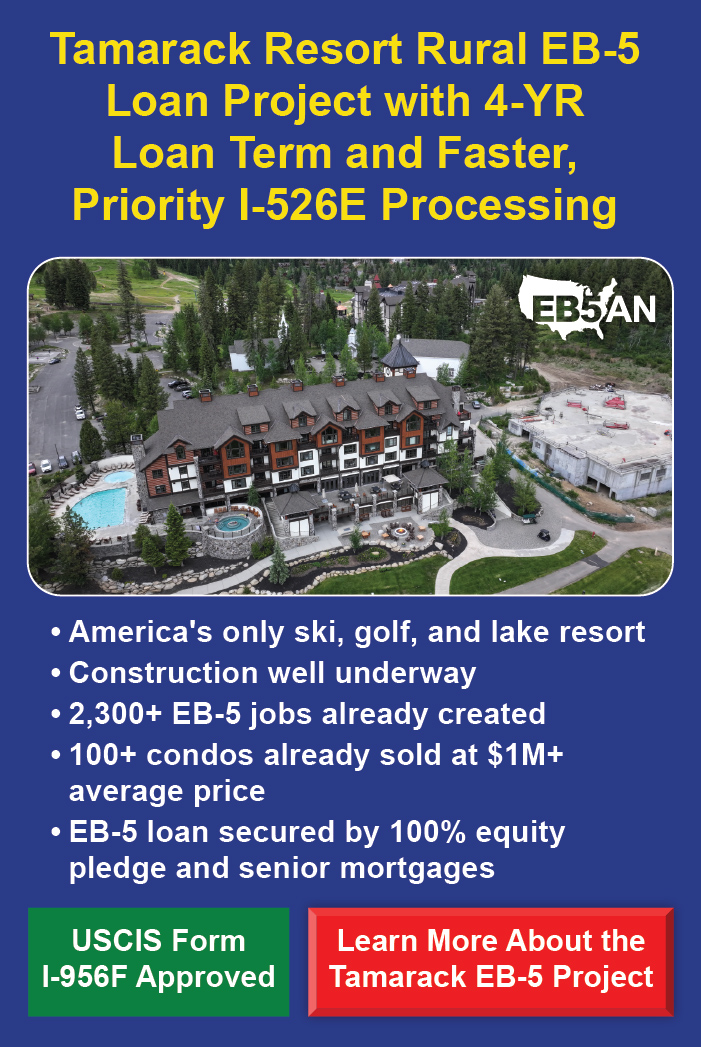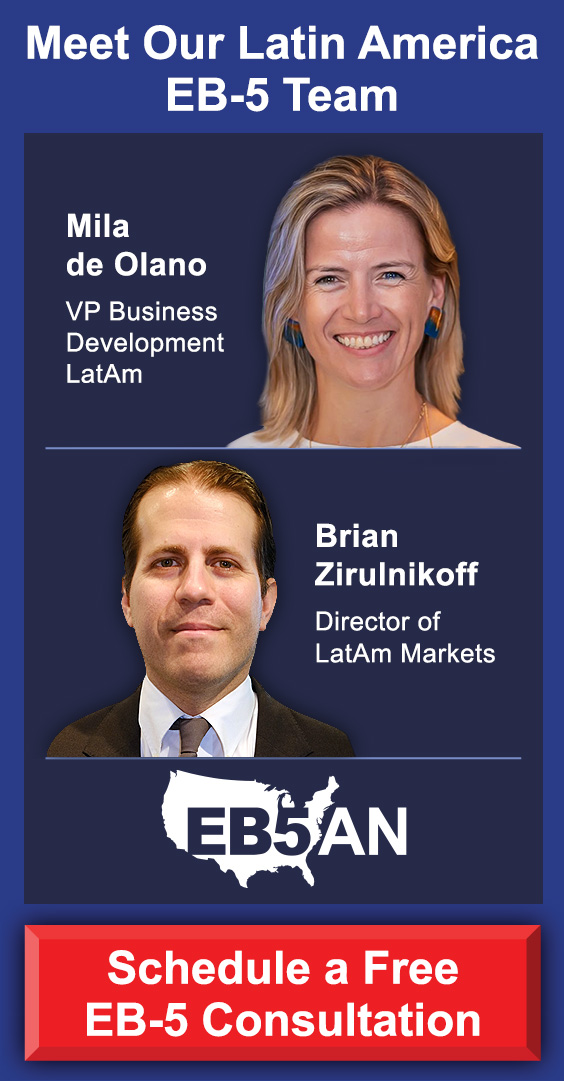An EB-5 investor must submit several petitions to United States Citizenship and Immigration Services (USCIS) and receive the agency’s approval to become a lawful permanent resident or citizen of the United States.
As a first step in their immigration process, EB-5 investors file a Form I-526 or Form I-526E. In this guide, we will explore why Form I-526/I-526E processing delays have been increasing, what risks they pose to EB-5 investors’ applications, and how to get approved fast.
What Are the I-526 and I-526E Petitions and Why Do They Matter?
I-526 Processing Times
- Why Does Form I-526 Take So Long to Process?
- How Is the I-526 Processing Time Calculated?
- How Do Long Processing Times Harm Investors?
How to Shorten Your I-526 Processing Time
- Invest in a Targeted Employment Area
- Follow All Requirements and Submit a Complete Set of Application Documents
- File Form I-485 at the Same Time
- Have Your Other Filing Fee Payments Ready
- Work With a Professional to File Your Petition
What to Do If Your I-526 Petition Is Still Taking Too Long
Contact EB5AN for Help With Your EB-5 Application
What Are the I-526 and I-526E Petitions and Why Do They Matter?
The I-526 petition is one of the most important forms for an EB-5 applicant. USCIS needs this form to determine whether an investor has complied with the requirements of the EB-5 Immigrant Investor Program. It is not possible to receive conditional residency—or later, a permanent Green Card—without an approved I-526.
An applicant must submit one of the following forms to qualify for an EB-5 visa, depending on the kind of investment they are making:
- Form I-526, Immigrant Petition by Standalone Investor.
- Form I-526E, Immigrant Petition by Regional Center Investor.
Investors must also file supporting evidence and documentation of their EB-5 compliance.
What Is Form I-526?
Form I-526, Immigrant Petition by Standalone Investor, is for EB-5 immigrant investors who directly invest their EB-5 capital in a qualifying new commercial enterprise (NCE) by themselves.
A standalone investor is responsible for much of the business’s day-to-day management.
New Commercial Enterprises
An NCE is usually a for-profit U.S. business that engages in lawful commercial activity and was established after November 29, 1990. Nearly any industry may qualify for EB-5 funding. A business established on or before that date also counts if it is reorganized to yield a new commercial or enterprise or if investment expands its net worth or number of employees by at least 40%.
What Is Form I-526E?
Form I-526E, Immigrant Petition by Regional Center Investor, is for EB-5 participants who invest via the regional center program. This is possible when a USCIS-designated regional center has proved that it supports the EB-5 program’s goals of stimulating the U.S. economy through job creation and foreign investment.
A regional center sponsors an EB-5 project in a specific geographic area. It also provides receipts and invoices to USCIS to verify that the investor created at least 10 full-time jobs required under the EB-5 program.
The vast majority of EB-5 investors choose the regional center option, primarily because it offers the following benefits:
- Easier tracking and documentation.
- Fewer management responsibilities.
- Greater flexibility in meeting job creation requirements.
- Ability to pool funds from multiple EB-5 investors, making larger investment projects possible.
But pursuing this option alone won’t guarantee a quick petition approval.
I-526 Processing Times
The median processing time for Form I-526 has increased every year since 2019, judging by USCIS’s Historical National Median Processing Time page.
In FY 2019, the median processing time was 19 months. However, by FY 2024 so far, the median processing time has jumped to 51.9 months.
Why Does Form I-526 Take So Long to Process?
Processing petitions is time-consuming work, and USCIS cannot adjudicate all of them promptly. The growing backlog reflects several factors.
First, the popularity of the EB-5 program has increased since it was established in 1990. USCIS now receives thousands of applications each year and needs to carefully examine all immigrant petitions.
Second, the COVID-19 pandemic has contributed to the I-526 backlog. For most of FY 2020-21, all U.S. consulates and embassies and nearly all immigration services were shut down.
USCIS staffing levels, policy and operational changes, and how long an applicant takes to respond to a request for more information are additional factors that affect processing efficiency.
Wait times also vary considerably depending on an investor’s nationality. As of March 2024, the wait time to adjudicate 80% of I-526 petitions from mainland China is 88 months, according to the USCIS processing times page. However, the wait time to process 80% of I-526 petitions from all other countries is a relatively short 55.5 months.
Why is there such a large difference?
The Immigration and Nationality Act requires that no more than 7% of available EB-5 visas be allocated to each participating nation. So an applicant from a populous, high-demand country will generally face more competition for an immigrant visa and a longer wait time.
Investors can check the latest processing times updates at any time on the USCIS website.
How Is the I-526 Processing Time Calculated?
The processing time figures reflect how much time it took USCIS to finish 80% of adjudicated cases. This figure is determined by counting the number of days between the receipt of an application and its decision on the case.
For example, suppose USCIS receives an application on January 26, 2024, and approves it on March 7, 2024. The processing time for this example is 42 days.
USCIS determines a processing time for each application it adjudicates in March 2024 and in the five preceding months.
Next, USCIS calculates how much time it took to decide on 80% of the cases during the six-month period. The resulting number becomes the processing time displayed on the USCIS page.
How Do Long Processing Times Harm Investors?
In addition to simply causing stress for EB-5 investors and their families, delayed processing can create other adverse consequences.
The longer an investor has to wait for I-526 adjudication, the more likely it is that their NCE could face unexpected business troubles. This could potentially jeopardize an investor’s compliance in the eyes of USCIS.
Investors’ unmarried children under the age of 21 could also age out of the EB-5 program before USCIS grants I-526 approval.
These issues could pose an immigration risk to investors.
How to Shorten Your I-526 Processing Time
Fortunately, prospective EB-5 investors can do several things to get their applications approved speedily.
One is to choose an EB-5 project wisely.
Invest in a Targeted Employment Area
Investors who want to avoid excessive wait times while saving hundreds of thousands of dollars should keep targeted employment areas (TEAs) in mind.
The United States created the EB-5 program to stimulate economic growth and create jobs for American workers. TEAs are high-unemployment or rural areas that need these jobs. So the United States reserves 32% of the total visa pool for individuals who invest in those projects or selected public infrastructure projects—another priority for investment.
This approach is especially helpful for investors from countries with EB-5 visa backlogs. By pursuing a rural TEA project, an EB-5 investor can receive priority processing.
The cost savings of this approach are also significant.
The typical minimum investment amount for an EB-5 project is $1,050,000. However, for an EB-5 investment made in a designated TEA, the minimum EB-5 investment amount is only $800,000.
Follow All Requirements and Submit a Complete Set of Application Documents
Investors need to note that EB-5 applications are sometimes held up because USCIS has to request additional information from them.
Avoid the hassle and delays by ensuring you’ve fulfilled all of the EB-5 program criteria and answered all questions fully and accurately when you submit your I-526 paperwork.
Each investor should submit a complete set of documents, including a strong business plan, in their immigrant investor petition for USCIS.
The exact mix will vary depending on individual circumstances and investment type. Since most EB-5 investors choose to invest via regional centers, we focus on the paperwork required under Form I-526E.
Your petition must answer questions related to the following:
- Petition type.
- Biographic information about the investor, their spouse, and children.
- Information about the regional center and project application.
- Proof the foreign national has made the minimum required capital investment and that these funds were lawfully obtained.
- Visa processing and immigration proceedings.
- Bona fides of those involved with the regional center program.
- Involvement in the regional center program.
You must also submit the following evidence with your I-526E petition:
- Receipt notice for an investment in a USCIS-designated regional center.
- Evidence you have invested or are investing the required amount of capital.
- Evidence the investment capital was obtained through lawful means.
- Photocopy of government-issued identification, such as a passport.
Do not forget to sign Form I-526E. USCIS rejects all unsigned forms.
File Form I-485 at the Same Time
An investor must also file Form I-485 to shift from nonimmigrant status to immigrant status and obtain conditional permanent residency. The I-485 petition for adjustment of status can be filed concurrently with Form I-526 or I-526E in the case of investors who are already present in the United States.
This option is available to investors whose country is listed as “C” or “current”—which means the country does not have a visa backlog, so the investor can apply for a visa—on the Visa Bulletin.
This change eliminates the additional wait time for I-485 adjudication, allowing non-resident EB-5 participants to live, work, or attend school in the U.S. while waiting for their I-526 or I-526E petitions to be adjudicated.
The filing fee for Form I-485 to adjust status is currently $1,140, per USCIS I-485 filing instructions updated on February 21, 2023. This will increase to $1,440 with the USCIS price increase of April 1, 2024.
Have Your Other Filing Fee Payments Ready
The filing fee for either Form I-526 or Form I-526E is currently $3,675, but will increase to $11,160 in April.
EB-5 investors should check the USCIS website for the latest information.
This non-refundable filing fee should be in the form of a check or a money order drawn from a U.S. bank or financial institution in U.S. currency.
Original checks will not be returned. If a check comes back unpayable twice, the I-526 petition will be rejected and the investor will be charged a fee.
Investors living outside the United States can contact their nearest U.S. embassy or consulate for instructions on how to submit payment.
Work With a Professional to File Your Petition
An immigration attorney usually files Form I-526 or Form I-526E on the investor’s behalf.
This person will check to ensure you have submitted copies of all required vital documents and enough evidence of the legal source of your investment funds.
Having the services of an experienced immigration lawyer will improve the chances of an EB-5 investor getting their Form I-526 or I-526E approved the first time, saving the investor the hassle of filing multiple petitions.
What to Do If Your I-526 Petition Is Still Taking Too Long
It’s possible for an investor to follow all of the guidance above and still experience excessive wait times. If you find yourself in this situation, you have a few options to pursue.
Submit a Formal Inquiry
USCIS allows an investor to submit a formal inquiry if their I-526 adjudication is taking significantly longer than the currently listed I 526 processing time on the USCIS website. This is an option if your application’s processing time exceeds that of 93% of other applications, which is far above the normal processing time.
To find out whether their petition is eligible for a formal inquiry, an EB-5 investor should:
- Go to the USCIS processing times page.
- Choose Form I-526 from the dropdown menu.
- Enter their I-526 filing receipt number.
If the investor’s petition adjudication is eligible for inquiry, a prompt will appear with further instructions about how to send an inquiry to the Immigrant Investor Program Office, the office within USCIS that adjudicates EB-5 petitions.
Allow 14 days for the office to respond.
Request Expedited Processing
In extreme cases, USCIS also allows for expedited adjudication of an investor’s I-526 or I-526E petition.
However, few EB-5 projects meet USCIS’ qualifications for expedited processing.
According to the USCIS website, the Immigrant Investor Program Office will only consider an expedite request if it meets one or more of the following criteria or circumstances:
- Severe financial loss to a company or person.
- Emergencies and urgent humanitarian reasons.
- U.S. government interests.
- Clear USCIS error.
Investors whose circumstances fit one or more of the criteria above will not automatically qualify for priority processing, however.
If an investor has the opportunity to invest in an EB-5 project with expedited processing approval, the investor and their family should consider doing so.
File a Writ of Mandamus
As a last resort, an EB-5 investor may take legal action by filing a writ of mandamus, under which a U.S. federal court would mandate that USCIS adjudicate Form I-526. However, the court cannot direct USCIS to approve the application; it can only compel a decision.
The investor would need to prove that they were subjected to an unreasonable delay that caused them harm.
EB5AN does not recommend pursuing this course of action without legal counsel.
Contact EB5AN for Help With Your EB-5 Application
The most important thing you can do to get your EB-5 application approved swiftly is to partner with the right professionals in the field.
EB5AN has helped more than 2,300 families from 60 countries relocate to the United States as lawful permanent residents. Our expert team has more than a decade of experience, and offers clients first-rate, low-risk EB-5 regional center projects with 100% USCIS project approval rate to date.
If you’re ready to start investing in an EB-5 project via a regional center, visit our page listing available EB-5 projects.
To get started with your I-526E petition, book a call with our EB-5 team and learn more about how to navigate your EB-5 immigration process.













